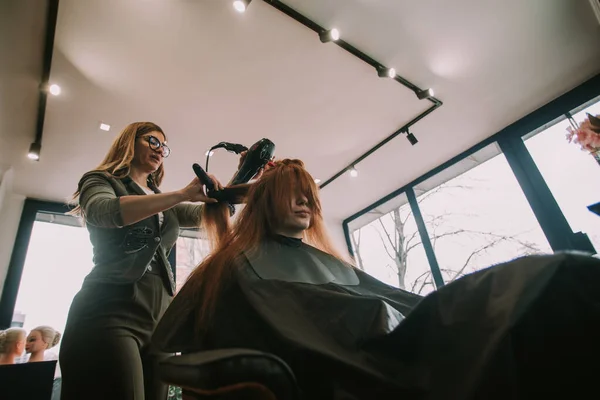Unlocking the science of hair texture and porosity empowers individuals to care for their unique hair characteristics which leads to healthier, more confident, beautiful locks.
At the hair salon in Mission Valley, assess your hair texture by gently stretching a strand between your thumb and forefinger. If it’s thin, it’s fine; if it feels thick and strong, it’s medium.
Coarse Hair
Coarse hair is characterized by thicker individual hair strands with a wider circumference. Coarse hair can be straight, wavy, curly, or tightly coiled, but the defining feature is its thickness.
While the term “coarse” often confuses with hair thickness (density of the scalp’s hair follicles), it is a separate identifier and refers to the texture and width of your hair.
If you are unsure of your hair texture, try rolling a strand between your fingers or comparing its width to that of a piece of thread.
Unlike thin and medium hair, coarse hair tends to be drier and can be prone to frizz in humid weather. Use a hair serum to help fight frizz and protect your strands from heat damage with a product that is free of silicone.
Coarse hair also holds styles better than other textures and is generally more tolerant to the effects of time, styling products, and hair dye. This makes it an ideal texture for creating full, luscious locks.
Medium Hair
Hair texture describes the diameter or thickness of individual strands of hair. It is typically broken down into three categories: fine, medium and coarse.
Fine hair strands are thinner in diameter than those of medium or coarse textures, and tend to break easily, get oily quickly and are prone to tangles. This type of hair typically requires light products and minimal heat styling.
Medium hair is generally thicker than fine hair and can be easier to manage, but it can still be prone to frizzing and breaking. This type of hair texture needs moderately sized products and often benefits from the addition of a leave-in conditioner.
Fine Hair
Hair texture describes the circumference and thickness of your individual strands. Fine hair strands are thinner in diameter than medium or coarse strands. If you’re unsure of your hair texture, try this simple test: Pluck a strand and compare it to a standard piece of thread. If the strand is much thinner than the thread, then you have fine hair. If it’s the same as or thicker than the thread, then you have medium hair.
For fine hair, lightweight products are ideal since they won’t weigh down your strands and cause flat roots or limp curls. Lightweight leave-ins, styling creams, and nourishing shampoos can help keep your hair looking full, healthy, and voluminous.
It’s also important to avoid long or short haircuts that require a lot of layering. For example, if you have fine hair, a “Rachel”-style bob with flicky layers will just make your hair look flat and wilted. Instead, consider a softer blonde balayage like a babylight balayage or dirty blonde ombre.
Combination Hair
You’ve probably heard the term “combined skin” applied to complexions, but it’s also a common hair condition. Having one area of your scalp that produces excess oil while another region is dry can throw off your styling routine and leave you with limp, flaky strands.
Experts say the best way to determine whether you have combination hair is to observe a strand of freshly washed, product-free hair that has dried without heat or manipulation.
If it dries straight, you have fine hair (type 1); if your strands have a slight bend or wavy pattern, you have wavy or curly hair (type 2 or type 3); and if your strands have tight curls or coils, you have spiral or coiled hair (type 4).
Once you know which category your hair falls into, you can find the right products to keep your scalp’s oils in check while nourishing your ends. These tips from industry trichologists and dermatologists can help you restore your hair’s harmony.
